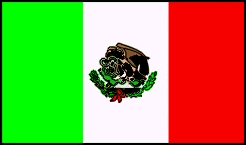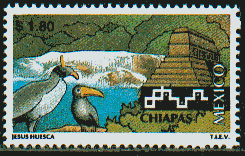


This biosphere reserve is located on the east coast of the Yucatan Peninsula. It contains tropical forests, mangroves and marshes, as well as a large marine section with a barrier reef. Sian Ka'an means "Where the Sky Begins" in the language of the Mayan peoples who once inhabited this region.

Major structures are Kukulcan pyramid, site of the Equinox solar phenomena, Temple of the Warriors, Temple of the Jaguars, El Mercado, Caracol, also known as the Observatory and the Ball Court (the largest in Mesoamerica). Another interesting part of the site is the Cenote or Sacred Well where ritual sacrifices of young women and children took place.
The Sierra de San Francisco (in the El Vizcaino reserve, in Baja California) was home to a people who have now disappeared. They lived in the area from 100 B.C. to 1300 A.D. and left behind an outstanding collection of rock paintings.

Zacatecas was founded in 1546 after the discovery of a very rich silver lode. The town is built on the steep slopes of a narrow valley, and offers a breathtaking panorama. Many old buildings, both religious and civil, remain.
There are fourteen monasteries included in this listing, built on the slopes of Popocatepetl, to the south-east of Mexico City. They are representative of the architectural model followed by the first missionaries - Franciscans, Dominicans and Augustinians - who introduced Christianity to the native populations at the beginning of the 16th century.
The name Xochicalco means "Place of Flowers".

A harbour town typical of the Spanish colonial period in the New World. It has kept its outer walls and system of fortifications, constructed to defend this Caribbean port against attacks from the sea.
Calakmul is a well preserved example of a significant phase in human settlement and the development of architecture over a period of more than 12 centuries. It is an important Maya site located deep in the tropical forest of the Tierras Bajas of southern Mexico.
This inscription includes the following missions: Santiago de Jalpan, Santa Maria del Agua de Landa, San Francisco del Valle de Tilaco, Nuestra Senora de la Luz de Tancoyol, and San Miguel Conca
The concrete house was built in a suburb of Mexico City in 1948. It was the home and studio of architect Luis Barragan whose work in the Modern Movement has influenced the contemporary design of gardens, plazas, and landscapes.
The Gulf of California contains two large islands, the Isla Angel de la Guarda and Tiburon Island as well as several smaller islands.
Tequila is the liquor produced from the blue agave around the town of Tequila in western Mexico. The designated area encloses a working landscape of blue agave fields, with its distilleries, factories and haciendas.
The campus is one of the most significant icons of modernity in Latin America. It was built from 1949 to 1952 by more than 60 architects, engineers and artists.
Located in rugged forested mountains about 100 km northwest of Mexico City. Every autumn, perhaps as many as a billion butterflies from wide areas of North America return to the site and cluster on small areas of the forest reserve. In the spring, these butterflies begin an 8 month migration that takes them all the way to Eastern Canada and back, during which time four successive generations are born and die. How they find their way back to their overwintering site remains a mystery.
The El Pinacate and Gran Desierto de Altar Biosphere Reserve is located in the Sonoran Desert along Mexico's northern border with the United States. The Sonora is one of North America's four great deserts; the others being the Chihuahuan, Mojave and Great Basin Deserts.

This 16th century aqueduct was initiated by the Franciscan friar, Padre Tembleque, and built with support from the local indigenous communities.
This site includes four remote Pacific islands known for their biodiversity and geological features. They are islands of volcanic origin, and some of the volcanoes are still very active.
Four sites:
Part of the Mesoamerican region, this semi-arid zone is one of the main centers of diversification for the cacti family, which is critically endangered worldwide.
Last updated: July 25, 2025